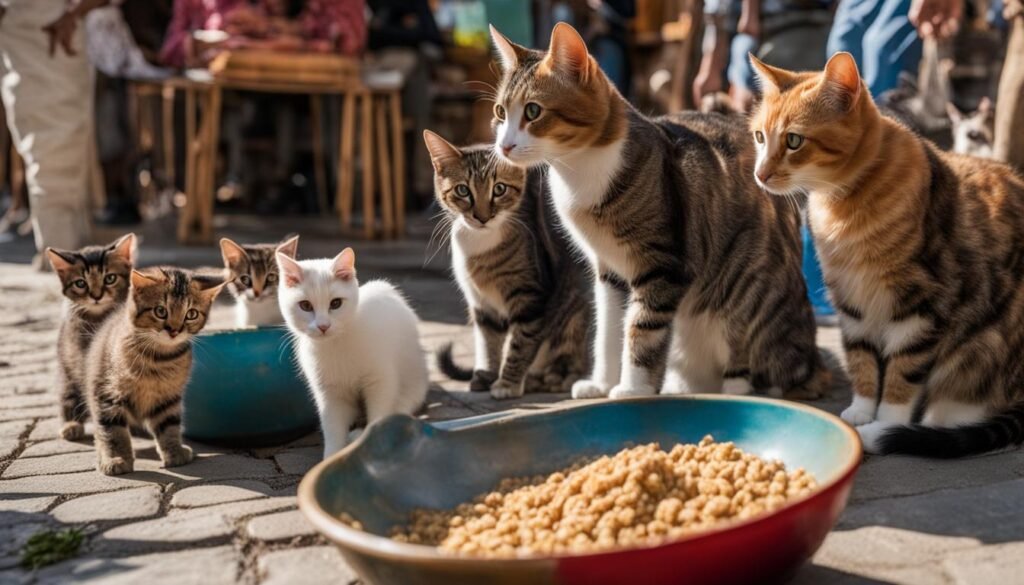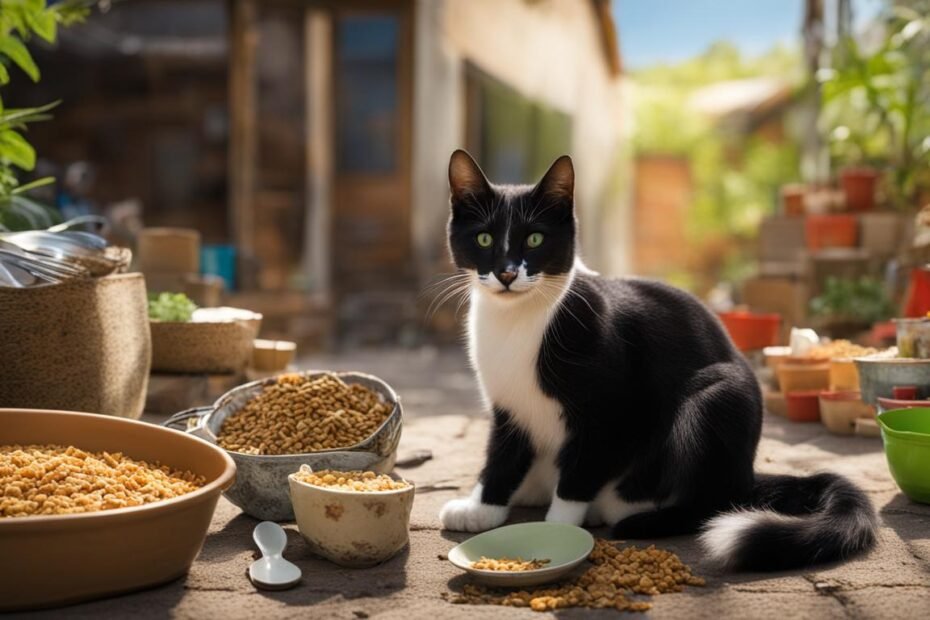Welcome to our comprehensive guide on stray cat care education. As cat enthusiasts and advocates, we believe in promoting responsible cat ownership and fostering feline friendliness in our communities. By providing education on how to care for stray cats, we can make a positive impact on their lives and overall welfare.
Cats are incredibly adaptable and resilient creatures. Although they have been domesticated over generations, they still retain their instincts for survival. Our guide aims to help you better understand the socialization continuum and how cats adapt to living with humans, empowering you as a cat guardian to provide the best care and protection for stray cats.
Throughout this guide, we will explore the importance of socialization, the different categories of cats within the socialization continuum, strategies for building trust with stray cats, and tips for helping them transition to a new home. We hope that by the end of this guide, you will feel equipped with knowledge and resources to make a difference in the lives of stray cats in your community.
Key Takeaways:
- Stray cat care education is essential for promoting responsible cat ownership.
- Understanding the socialization continuum helps in providing appropriate care and support to stray cats.
- Building trust with stray cats is a gradual process that requires patience and understanding.
- If you decide to adopt a stray cat, providing a safe and comfortable environment is crucial for their transition.
- Stray cat care education can inspire more people to become advocates for community cats.
What is Socialization?
Socialization refers to a cat’s level of comfort and familiarity with humans. It is a continuum that ranges from highly socialized cats that are comfortable living in homes to unsocialized feral cats that actively avoid contact with people. Domestication, on the other hand, is a process that occurs over generations and refers to a species adapting to live with or among humans for their own benefit. Cats have become domesticated over thousands of years, but they still retain their wild instincts and can survive independently outdoors. Understanding the difference between socialization and domestication is crucial for providing appropriate care and support to stray cats.
The Continuum of Socialization: Feral, Stray, and Pet Cats
Within the socialization continuum, there are three distinct categories: feral, stray, and pet cats. Feral cats are unsocialized outdoor cats that have little to no contact with humans and prefer to avoid human interaction. Stray cats, on the other hand, are former pet cats that have been abandoned or lost and may still have some level of socialization towards humans. Pet cats are fully socialized to humans and are comfortable living indoors and interacting with their human caregivers. Understanding these categories helps in determining the best course of action for helping each cat and promoting their overall well-being.

“Socialization is a crucial factor in determining a stray cat’s comfort level with humans. By understanding their distinct categories within the socialization continuum, we can provide the appropriate care and support needed for their well-being.”
Table: Socialization Continuum
| Category | Description |
|---|---|
| Feral Cats | Unsocialized outdoor cats with minimal to no contact with humans; prefer to avoid human interaction |
| Stray Cats | Former pet cats that have been abandoned or lost; may still have some level of socialization towards humans |
| Pet Cats | Fully socialized cats comfortable living indoors and interacting with humans |
By understanding the socialization continuum and the categories within it, we can provide targeted care and support to stray cats. Feral cats may require programs like Trap-Neuter-Return (TNR) to manage their population and improve their welfare. Stray cats may benefit from efforts to regain their trust through patience and positive associations. Pet cats may require assistance in finding forever homes or reuniting with their previous owners. Each category presents unique challenges and opportunities for helping stray cats and ensuring their well-being in our communities.
The Continuum of Socialization: Feral, Stray, and Pet Cats
Understanding the different categories within the socialization continuum is essential for providing appropriate care and support to stray cats. This continuum encompasses feral cats, stray cats, and pet cats, each with their own unique characteristics and needs.
Feral Cats
Feral cats are unsocialized outdoor cats that have had little to no contact with humans. They often prefer to avoid human interaction and may exhibit fear or aggression when approached. Feral cats typically live in colonies and rely on their instincts for survival in the wild. They can be found in various locations, such as urban areas, rural communities, and industrial sites. Due to their limited socialization with humans, feral cats are not suitable for adoption as pets and are best managed through programs like Trap-Neuter-Return (TNR) to stabilize their population and improve their welfare.
Stray Cats
Stray cats are former pet cats that have been abandoned or lost and may still retain some level of socialization towards humans. They are often found roaming outdoors and may seek food and shelter from humans or in urban environments. Stray cats may show varying degrees of comfort with human interaction, ranging from cautiously friendly to skittish. While some stray cats may be successfully rehomed with proper socialization and care, others may prefer to live independently outdoors. It’s important to assess each stray cat’s individual needs and provide appropriate support accordingly.
Pet Cats
Pet cats are fully socialized to humans and are comfortable living indoors and interacting with their human caregivers. These cats have been domesticated over generations and have adapted to living in human households. They rely on humans for their basic needs, such as food, water, shelter, and companionship. Pet cats form strong bonds with their owners and thrive in a safe and secure indoor environment. Responsible cat ownership includes providing proper veterinary care, enrichment, and a loving home for pet cats to ensure their well-being.
Table: Comparison of Feral, Stray, and Pet Cats
| Category | Characteristics | Suitability for Adoption |
|---|---|---|
| Feral Cats | Unsocialized, prefer to avoid human interaction | Not suitable for adoption, best managed through TNR programs |
| Stray Cats | Former pet cats, varying degrees of socialization towards humans | Some may be successfully rehomed with proper care and socialization |
| Pet Cats | Fully socialized to humans, comfortable living indoors | Suitable for adoption as companion animals |
The continuum of socialization highlights the diverse range of cats that exist in our communities. By understanding the characteristics and needs of feral, stray, and pet cats, we can tailor our approach to providing the best care and support for each category. This includes implementing TNR programs for feral cats, offering resources and assistance for stray cats, and promoting responsible pet ownership for pet cats. Together, we can make a positive difference in the lives of cats and create a more compassionate society for all feline friends.
Building Trust with Stray Cats
Building trust with stray cats is a gradual process that requires patience and understanding. One of the most effective ways to gain their trust and establish a positive association with humans is through feeding. By providing food and water for stray cats, we can show them that we are a source of sustenance and care.
Start by leaving food in a consistent location, preferably in a quiet and safe area where the cat feels comfortable. As you do this, observe the cat’s behavior from a distance, allowing them to become familiar with your presence. Over time, the cat will start to associate you with the provision of food, and their fear or wariness may begin to subside.
When the cat becomes more comfortable with your presence, you can try to approach them slowly and calmly. Avoid any sudden movements or aggressive behavior, as this may scare them away. Let the cat set the pace of the interaction and respect their boundaries. With time and persistence, your gentle approach can help build a sense of trust between you and the stray cat.

“The love and care we show to stray cats can help heal their wounds and restore their trust in humans.” – Anonymous
Remember, building trust with stray cats is a process that requires time and patience. Each cat is unique and may respond differently to human interaction. It’s important to approach them with kindness and respect, allowing them to feel safe and comfortable in your presence. By building a positive relationship with stray cats, we can make a significant difference in their lives and improve their overall well-being.
Helping Stray Cats Transition to a New Home
When you decide to open your heart and home to a stray cat, it’s important to help them adjust to their new environment. The transition to indoor life can be overwhelming for a cat that has spent its days outdoors, but with patience and care, you can make the process smoother for both you and your new furry friend.
Adoption: Creating a Safe Space
First, create a dedicated space for the cat to acclimate to its new surroundings. Set up a quiet room with food, water, and a litter box. This room will serve as a safe haven where the cat can retreat to when feeling overwhelmed. Gradually introduce the cat to the rest of your home, allowing it to explore one room at a time. Give the cat time to adjust and respect its boundaries during this critical period of adaptation.
Veterinary Care: Ensuring a Healthy Start
Once you’ve welcomed the stray cat into your home, schedule a visit to the veterinarian. A comprehensive health assessment and necessary vaccinations are essential to ensure the cat’s well-being and protect other pets in your household. The veterinarian will also be able to provide guidance on any specific medical needs the cat may have and give you advice on proper nutrition and preventive care.
Patience and Love: Building Trust and a Strong Bond
Building trust with your new companion takes time and patience. Let the cat set the pace for interactions and allow it to approach you when it feels comfortable. Offer treats, gentle petting, and playtime to create positive associations. Remember that each cat is unique and may require different approaches to build trust. With love, understanding, and consistent care, your stray cat will gradually adapt to its new home and form a deep bond with you.
| Transitioning to Indoor Life: Tips and Recommendations |
|---|
| Make the environment enriching with toys, scratching posts, and cozy hiding spots. |
| Establish a routine for feeding, playtime, and litter box maintenance. |
| Provide vertical spaces like cat trees or shelves for climbing and exploring. |
| Introduce the cat to other pets gradually, using positive reinforcement and supervised interactions. |
| Offer plenty of affection, reassurance, and a calm environment to help the cat feel secure. |
By following these guidelines and providing a nurturing environment, you can help your stray cat successfully transition to a happy and fulfilling life as a cherished indoor pet.
Conclusion
Stray cat advocacy and community cat education play a crucial role in promoting responsible cat ownership and improving the welfare of these vulnerable feline friends.
By understanding the socialization continuum and the unique needs of stray cats, we can provide better care and support to these animals. Building trust with stray cats is a gradual process that requires patience and kindness, starting with offering food and water as a way to establish a positive association with humans.
As responsible cat owners, it is essential to help stray cats transition to a new home by creating a safe and comfortable environment, gradually introducing them to the house, and providing regular veterinary care. This ensures their health and prevents the spread of diseases.
By advocating for stray cat care, practicing community cat education, and promoting responsible cat ownership, we can make a significant impact on the lives of these cats and create a more compassionate society that values and protects their well-being.
FAQ
What is the importance of stray cat care education?
Stray cat care education is essential for promoting responsible cat ownership in communities and raising awareness about the needs of stray cats. It helps advocates, shelter staff, caregivers, and veterinary professionals better care for and protect stray cats.
What is socialization in cats?
Socialization refers to a cat’s level of comfort and familiarity with humans. It is a continuum that ranges from highly socialized cats that are comfortable living in homes to unsocialized feral cats that actively avoid contact with people.
What is the difference between socialization and domestication?
Socialization refers to a cat’s comfort with humans, while domestication is a process that occurs over generations and refers to a species adapting to live with or among humans for their own benefit. Cats have become domesticated over thousands of years but still retain their wild instincts.
What are the categories within the socialization continuum?
The categories within the socialization continuum are feral, stray, and pet cats. Feral cats are unsocialized outdoor cats, stray cats are former pet cats that may still have some level of socialization towards humans, and pet cats are fully socialized to humans and comfortable living indoors.
How can I build trust with stray cats?
Building trust with stray cats is a gradual process that requires patience and understanding. Providing food and water for stray cats is one of the most effective ways to gain their trust and establish a positive association with humans.
How do I help a stray cat transition to a new home?
If you decide to adopt a stray cat and bring it into your home, it’s important to help them adjust to their new environment. Start by keeping the cat in a quiet room initially, providing food, water, and a litter box. Gradually introduce the cat to the rest of your home, allowing them to explore at their own pace.
Why is veterinary care important for stray cats?
Taking the stray cat to a veterinarian for a thorough health assessment and necessary vaccinations is crucial. This ensures that the cat is in good health and helps prevent the spread of diseases.
How can stray cat care education make a difference?
Stray cat care education promotes responsible cat ownership and improves the welfare of community cats. It helps in understanding the needs of stray cats and inspires more people to become cat advocates. Together, we can create a more compassionate society that values and protects the well-being of all cats.
